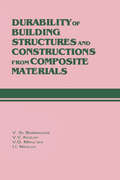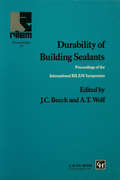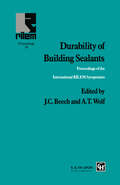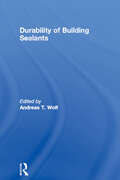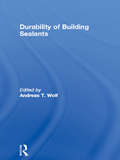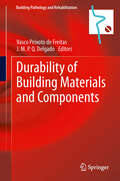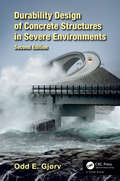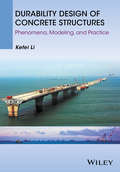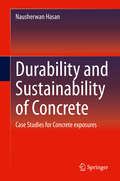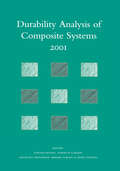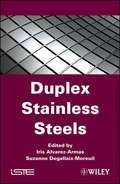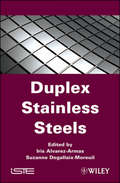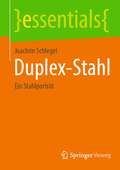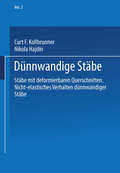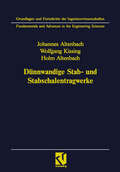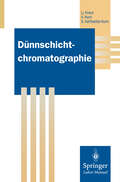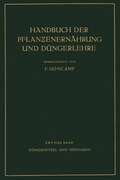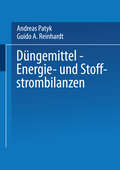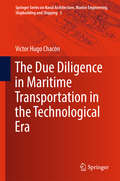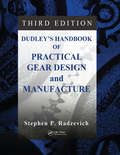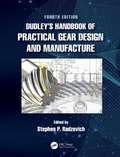- Table View
- List View
Durability of Building Structures and Constructions from Composite Materials: Russian Translations Series 109
by V. Sh. Barbakadze V.V. Kozlov V.G. Mikul'skii I.I. NikolovThis text deals with the estimation, prediction and improvement of the durability of building structures and constructions from composite materials with inorganic, organic and mixed binders. It describes a method for improving the durability of structures and constructions.
Durability of Building Structures and Constructions from Composite Materials: Russian Translations Series 109
by V. Sh. Barbakadze V.V. Kozlov V.G. Mikul'skii I.I. NikolovThis text deals with the estimation, prediction and improvement of the durability of building structures and constructions from composite materials with inorganic, organic and mixed binders. It describes a method for improving the durability of structures and constructions.
Durability of Building Sealants
by J.C. Beech A.T. WolfThis book presents the papers given at the RILEM Seminar held at the Building Research Establishment, Garston, UK in October 1994. The book provides an opportunity for researchers to review up-to-date progress towards the achievement of the objectives of the standardisation of laboratory techniques of sealants in the variety of service conditions to which they are exposed.
Durability of Building Sealants: 4th Volume
by J.C. Beech A.T. WolfThis book presents the papers given at the RILEM Seminar held at the Building Research Establishment, Garston, UK in October 1994. The book provides an opportunity for researchers to review up-to-date progress towards the achievement of the objectives of the standardisation of laboratory techniques of sealants in the variety of service conditions to which they are exposed.
Durability of Building Sealants: 4th Volume
by A. T. WolfThis volume contains the proceedings of the Second International Symposium on Durability of Building Sealants, held under the joint auspices of the British Building Research Establishment Ltd (BRE) and the International Union of Testing and Research Laboratories for Buildings and Structures (RILEM) Technical Committee 139-DBS. The twelve contributions in this volume reflect the wide spectrum of current research and provide for the development of an International Standard on Sealant Durability.
Durability of Building Sealants
by Andreas T. WolfThis volume contains the proceedings of the Second International Symposium on Durability of Building Sealants, held under the joint auspices of the British Building Research Establishment Ltd (BRE) and the International Union of Testing and Research Laboratories for Buildings and Structures (RILEM) Technical Committee 139-DBS. The twelve contributions in this volume reflect the wide spectrum of current research and provide for the development of an International Standard on Sealant Durability.
Durability of Building Materials and Components (Building Pathology and Rehabilitation #3)
by Vasco Peixoto Freitas and J. M. P. Q. DelgadoDurability of Building Materials and Components provides a collection of recent research works to contribute to the systematization and dissemination of knowledge related to the long-term performance and durability of construction and, simultaneously, to show the most recent advances in this domain. It includes a set of new developments in the field of durability, service life prediction methodologies, the durability approach for historical and old buildings, asset and maintenance management and on the durability of materials, systems and components. The book is divided in several chapters that intend to be a resume of the current state of knowledge for benefit of professional colleagues.
Durability Design of Concrete Structures in Severe Environments
by Odd E. GjørvOne of the most pressing problems facing the construction industry globally is the deterioration of major concrete infrastructure in marine and other chloride-containing environments. While recent advancements in concrete technology have made it easier to control the negative impact of deteriorating processes such as alkali-aggregate reaction, free
Durability Design of Concrete Structures: Phenomena, Modeling, and Practice
by Kefei LiComprehensive coverage of durability of concrete at both material and structural levels, with design related issues Links two active fields in materials science and structural engineering: the durability processes of concrete materials and design methods of concrete structures Facilitates communication between the two communities, helping to implement life-cycle concepts into future design methods of concrete structures Presents state-of-the-art information on the deterioration mechanism and performance evolution of structural concrete under environmental actions and the design methods for durability of concrete structures Provides efficient support and practical tools for life-cycle oriented structural design which has been widely recognized as a new generation of design philosophy for engineering structures The author has long experience working with the topic and the materials presented have been part of the author's current teaching course of Durability and Assessment of Engineering Structures for graduate students at Tsinghua University The design methods and approaches for durability of concrete structures are developed from newly finished high level research projects and have been employed as recommended provisions in design code including Chinese Code and Eurocode 2
Durability Design of Concrete Structures: Phenomena, Modeling, and Practice
by Kefei LiComprehensive coverage of durability of concrete at both material and structural levels, with design related issues Links two active fields in materials science and structural engineering: the durability processes of concrete materials and design methods of concrete structures Facilitates communication between the two communities, helping to implement life-cycle concepts into future design methods of concrete structures Presents state-of-the-art information on the deterioration mechanism and performance evolution of structural concrete under environmental actions and the design methods for durability of concrete structures Provides efficient support and practical tools for life-cycle oriented structural design which has been widely recognized as a new generation of design philosophy for engineering structures The author has long experience working with the topic and the materials presented have been part of the author's current teaching course of Durability and Assessment of Engineering Structures for graduate students at Tsinghua University The design methods and approaches for durability of concrete structures are developed from newly finished high level research projects and have been employed as recommended provisions in design code including Chinese Code and Eurocode 2
Durability and Sustainability of Concrete: Case Studies for Concrete exposures
by Nausherwan HasanThis book provides practicing engineers with a step by step approach for making durable concrete with optimum use of the local materials available within the various regions of the United States. It further includes actual concrete mixture proportions for high performance concrete for strength and durability under various aggressive environments based on the author’s experience in the field, and support this with illustrative case studies. Examples for concrete mixture proportions, based on the current industry practice and standards, are highlighted to assist engineers in meeting the intended performance requirements (for specific environment conditions) for durable concrete. Covering an important topic for the construction and building materials industries, this book delivers the most up-to-date industry practices and advances in concrete construction from the perspective of a practicing engineer with over 40 year experience.Maximizes practicing engineers’ understanding of best design and construction practices in fabricating, delivery, and installation of concrete, consistent with current knowledge on concrete durabilityDiscusses quality control and testing requirements during design and construction, including mixing, production, and placement of concrete and tolerances for slump and air contentEmphasizes real-world examples of optimal concrete mixtures, suitable for selected service conditions and applications, based on prior successful records of projects within the USAddresses the role of innovative admixtures in concrete placement in cold weather conditions below 32F and meeting the strength and durability requirementsServes as a valuable resource for students in graduate programs
Durability Analysis of Composite Systems 2001: Proceedings of the 5th International Conference , DURACOSYS 2001, tokyo, 6-9 November 2001
by Y. Miyano A. H. Cardon A. H. Reifsnider H. Fukada S. OgiharaThis proceedings covers the general problem related to the damage initiation and development, the failure criteria and the specific aspects related to fatigue, creep behaviour, moisture diffusion and the problem of the joining systems.
Durability Analysis of Composite Systems 2001: Proceedings of the 5th International Conference , DURACOSYS 2001, tokyo, 6-9 November 2001
by Yasushi Miyano, Albert H. Cardon, Ken L. Reifsnider, Hiroshi Fukuda and Shinji OgiharaThis proceedings covers the general problem related to the damage initiation and development, the failure criteria and the specific aspects related to fatigue, creep behaviour, moisture diffusion and the problem of the joining systems.
Duplex Stainless Steels (Iste Ser.)
by Iris Alvarez-Armas Suzanne Degallaix-MoreuilDuplex Stainless Steels (DSSs) are chromium-nickel-molybdenum-iron alloys that are usually in proportions optimized for equalizing the volume fractions of austenite and ferrite. Due to their ferritic-austenitic microstructure, they possess a higher mechanical strength and a better corrosion resistance than standard austenitic steels. This type of steel is now increasing its application and market field due to its very good properties and relatively low cost. This book is a review of the most recent progress achieved in the last 10 years on microstructure, corrosion resistance and mechanical strength properties, as well as applications, due to the development of new grades. Special attention will be given to fatigue and fracture behavior and to proposed models to account for mechanical behavior. Each subject will be developed in chapters written by experts recognized around the international industrial and scientific communities. The use of duplex stainless steels has grown rapidly in the last 10 years, particularly in the oil and gas industry, chemical tankers, pulp and paper as well as the chemical industry. In all these examples, topics like welding, corrosion resistance and mechanical strength properties (mainly in the fatigue domain) are crucial. Therefore, the update of welding and corrosion properties and the introduction of topics like texture effects, fatigue and fracture strength properties, and mechanical behavior modeling give this book specific focus and character.
Duplex Stainless Steels
by Iris Alvarez-Armas Suzanne Degallaix-MoreuilDuplex Stainless Steels (DSSs) are chromium-nickel-molybdenum-iron alloys that are usually in proportions optimized for equalizing the volume fractions of austenite and ferrite. Due to their ferritic-austenitic microstructure, they possess a higher mechanical strength and a better corrosion resistance than standard austenitic steels. This type of steel is now increasing its application and market field due to its very good properties and relatively low cost. This book is a review of the most recent progress achieved in the last 10 years on microstructure, corrosion resistance and mechanical strength properties, as well as applications, due to the development of new grades. Special attention will be given to fatigue and fracture behavior and to proposed models to account for mechanical behavior. Each subject will be developed in chapters written by experts recognized around the international industrial and scientific communities. The use of duplex stainless steels has grown rapidly in the last 10 years, particularly in the oil and gas industry, chemical tankers, pulp and paper as well as the chemical industry. In all these examples, topics like welding, corrosion resistance and mechanical strength properties (mainly in the fatigue domain) are crucial. Therefore, the update of welding and corrosion properties and the introduction of topics like texture effects, fatigue and fracture strength properties, and mechanical behavior modeling give this book specific focus and character.
Duplex-Stahl: Ein Stahlporträt (essentials)
by Joachim SchlegelDie Welt des Stahls ist erstaunlich vielfältig und so komplex, dass sie in der Praxis nicht leicht zu überblicken ist. In Form von essentials zu Porträts von ausgewählten Stählen und Stahlgruppen soll dem Leser diese Welt des Stahls nähergebracht werden; kompakt, verständlich, informativ, strukturiert mit Beispielen aus der Praxis und geeignet zum Nachschlagen.Vor über 90 Jahren wurden als jüngste Gruppe von nichtrostenden Stählen die Duplex-Stähle entwickelt. Mit ihren besonderen mechanischen Eigenschaften bei sehr hoher Korrosionsbeständigkeit finden sie zunehmend für last- und korrosionsbeanspruchte Anforderungen Anwendung. Wissenswertes über diese Stähle fasst dieses essential zusammen.
Dünnwandige Stäbe: Band 2: Stäbe mit deformierbaren Querschnitten Nicht-elastisches Verhalten dünnwandiger Stäbe (pdf)
by Curt F. Kollbrunner Nikola HajdinDünnwandige Stab- und Stabschalentragwerke: Modellierung und Berechnung im konstruktiven Leichtbau (Grundlagen und Fortschritte der Ingenieurwissenschaften)
by Johannes Altenbach Wolfgang Kissing Holm AltenbachDieses Buch wendet sich an Berechnungsingenieure in Ausbildung und Praxis, die an Problemen der Festigkeit, des Maschinenbaus, der Luft- und Raumfahrt oder des Schiffbaus arbeiten.
Dünnschichtchromatographie (Springer Labormanuale)
by Ljubomir Kraus Angelika Koch Sabrina Hoffstetter-KuhnDieser praxisbezogene Leitfaden geht speziell auf die von L. Kraus entwickelte Horizontalkammer ein, eine zugelassene Methode, die von der WHO zur Kontrolle von Arzneipflanzen anerkannt ist. Die DC-Technik, stationäre und mobile Phasen und Nachweismethoden werden ausführlich beschrieben und durch zahlreiche Anwendungsbeispiele und exzellente Farbabbildungen der wichtigsten Chromatogramme ergänzt.
Düngemittel und Düngung (Handbuch der Pflanzenernährung und Düngung #2)
by E. Bierei H. Brenek R. Demoll R. Doerell H. Fischer W. Gleisberg C. Grimme C. Hermann F. Honcamp W. Jacob A. Kilbinger P. Koenig P. Krische G. Leimbach N. NicolaisenDieser Buchtitel ist Teil des Digitalisierungsprojekts Springer Book Archives mit Publikationen, die seit den Anfängen des Verlags von 1842 erschienen sind. Der Verlag stellt mit diesem Archiv Quellen für die historische wie auch die disziplingeschichtliche Forschung zur Verfügung, die jeweils im historischen Kontext betrachtet werden müssen. Dieser Titel erschien in der Zeit vor 1945 und wird daher in seiner zeittypischen politisch-ideologischen Ausrichtung vom Verlag nicht beworben.
Düngemittel — Energie- und Stoffstrombilanzen
by Andreas Patyk Guido A. ReinhardtEnergie- und Stoffstrombilanzen bilden das Herzstück jeder Ökobilanz. Ökobilanzen wiederum gehören zu den wichtigsten Werkzeugen zur Beschreibung der Umweltverträglichkeit eines Produktes. Unerläßlich ist dabei eine ausführliche Darstellung der Vorgehensweise und die Dokumentation ausnahmslos aller Primärdaten, damit die Bilanzen nachvollziehbar und nachprüfbar sind. Am Beispiel der Düngemittel wird dies Punkt für Punkt akribisch genau durchgeführt und bis ins Detail mit Zahlen untermauert. Damit dient dieses Buch dem Ökobilanzierer nicht nur als Beispiel dafür, was bei der Erstellung von Energie- und Stoffstrombilanzen alles zu beachten ist. Er findet darüber hinaus für die im Kontext der Ökobilanz im Agrarbereich äußerst wichtigen Düngemittel eine in diesem Umfang bisher noch nicht dagewesene Datenfülle.
The Due Diligence in Maritime Transportation in the Technological Era (Springer Series on Naval Architecture, Marine Engineering, Shipbuilding and Shipping #5)
by Víctor Hugo ChacónThis book discusses the problem of sea carriers’ liability, with a particular focus on role of the technologies that have been employed to support maritime transport in recent decades. It examines the Hague Rules, providing an overview of the precedent standard of liability, its historical development up until its application, and its construction at the current time. To do so, it presents two exemplary studies from English and American case law, and analyzes the situations in which the courts have required the application of new technologies as part of the duties set in the current governing liability regime. Written in an easy-to-follow style, the book offers not only an unique overview of the applications of technologies in making ships both seaworthy and cargo-worthy, but also a practice-oriented guide to understanding and making decisions about sea carriers’ liability. It is intended for law practitioners as well as advanced graduate students and researchers in the field of maritime shipping, transport and insurance law
Dudley's Handbook of Practical Gear Design and Manufacture
by Stephen P. RadzevichDudley's Handbook of Practical Gear Design & Manufacture, Third Edition, is the definitive reference work for gear design, production, inspection, and application. This fully updated edition provides practical methods of gear design, and gear manufacturing methods, for high-, medium-, and low-volume production. Comprehensive tables and references are included in the text and in its extensive appendices, providing an invaluable source information for all those involved in the field of gear technology.
Dudley's Handbook of Practical Gear Design and Manufacture
by Stephen P. RadzevichThe Fourth Edition of Dudley’s Handbook of Practical Gear Design and Manufacture is the definitive reference guide to gear design, production, and applications. Using a pragmatic approach, the book provides gear manufacturing methods for high-, medium-, and low-volume production. Updated throughout to reflect cutting-edge research, this edition includes new contributions from experts in the field. Providing a clear overview of the foundations of advanced gear systems, the book contains new material on the potential of technologies such as high-performance plastic gears alongside issues that can be encountered. The book also includes innovative chapters discussing topics such as involute gear drives and gear strength calculation, with new regulations such as ISO 6336 in mind. Using modern technologies such as powder metallurgy and additive manufacturing, all the necessary information to reduce gear cost is provided. Additionally, gear micro-geometry modifications and planetary gear designs are discussed. FEATURES Provides an up-to-date, single-source reference for all aspects of the gear industry Presents an integrated approach to gear design and manufacture Includes new coverage of direct gear design and ready-to-use gear design Contains coverage of finite element analysis, gear vibration, load ratings, and gear failures The book includes comprehensive tables and references, making this the definitive guide for all those in the field of gear technology, from industry professionals to undergraduate and postgraduate engineering students.
Dudley's Handbook of Practical Gear Design and Manufacture
by Stephen P. RadzevichThe Fourth Edition of Dudley’s Handbook of Practical Gear Design and Manufacture is the definitive reference guide to gear design, production, and applications. Using a pragmatic approach, the book provides gear manufacturing methods for high-, medium-, and low-volume production. Updated throughout to reflect cutting-edge research, this edition includes new contributions from experts in the field. Providing a clear overview of the foundations of advanced gear systems, the book contains new material on the potential of technologies such as high-performance plastic gears alongside issues that can be encountered. The book also includes innovative chapters discussing topics such as involute gear drives and gear strength calculation, with new regulations such as ISO 6336 in mind. Using modern technologies such as powder metallurgy and additive manufacturing, all the necessary information to reduce gear cost is provided. Additionally, gear micro-geometry modifications and planetary gear designs are discussed. FEATURES Provides an up-to-date, single-source reference for all aspects of the gear industry Presents an integrated approach to gear design and manufacture Includes new coverage of direct gear design and ready-to-use gear design Contains coverage of finite element analysis, gear vibration, load ratings, and gear failures The book includes comprehensive tables and references, making this the definitive guide for all those in the field of gear technology, from industry professionals to undergraduate and postgraduate engineering students.
